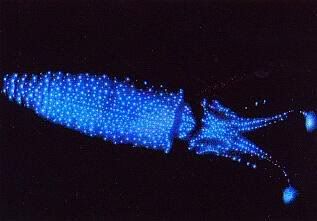La bioluminiscencia del calamar volador de fuego
Published Monday, July 11, 2005 by Spyder | E-mail this postFirefly squid
The firefly squid (Watasenia scintillans) is, like all squids, a member of the class Cephalopoda, subclass Coleoidea, order Teuthida.
The firefly squid (Watasenia scintillans) is, like all squids, a member of the class Cephalopoda, subclass Coleoidea, order Teuthida.
Species characteristics
The firefly squid is found in the Western Pacific ocean at depths of 600 to 1200 feet. The species possesses luminescent properties (see Bioluminescence). Each tentacle has an organ called a photophore, which produces light. By flashing these lights, the firefly squid can attract small fish to feed upon.
The firefly squid at maturity measures about 3 inches long and dies after one year of life.
Mating
The firefly squid can also light up its whole body to attract a mate. The mating season of the firefly squid lasts from March to June.

Fotografía espectacular de una calamar volador de fuego
ATP-Dependent Bioluminescence in the Firefly Squid, Watasenia Scintillans
Frederick I. Tsuji
The Japanese firefly squid, Watasenia scintillans, emits intense flashes of light from three tiny luminous organs that are located at the tip of each of a pair of ventral arms. Light is also produced from hundreds of other minute organs that are scattered over the body. The luminescence is due to an ATP-dependent reaction, with an optimal pH of 8.80. The decay of light intensity follows first-order kinetics and the decay constant is independent of initial ATP concentration. The light emission also requires MgCl2, a soluble component, and an insoluble component that is membrane bound. Squids represent a major group of organisms unrelated to fireflies in which ATP is required for bioluminescence.
Labels: Características, Comportamiento



0 Responses to “La bioluminiscencia del calamar volador de fuego”
Leave a Reply